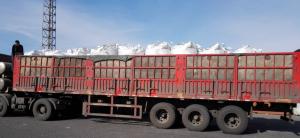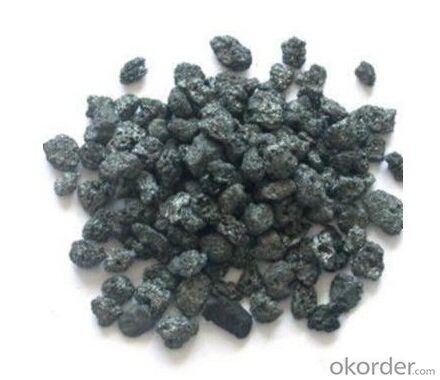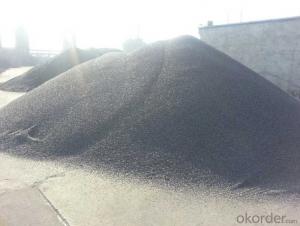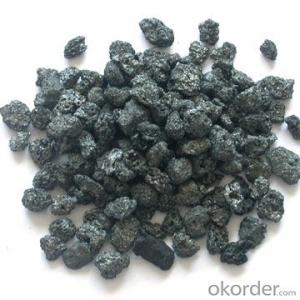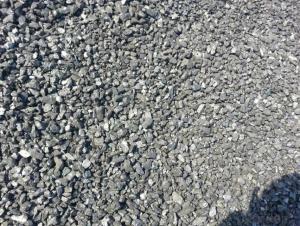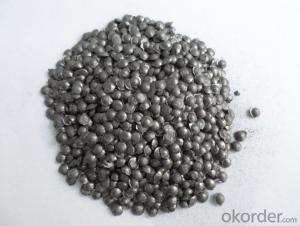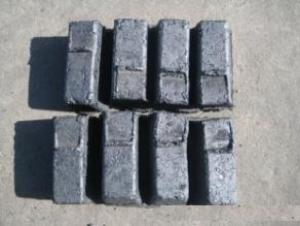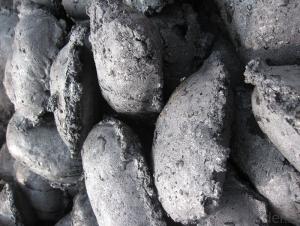CPC Powder High FC Carbon Low Sulfur Low Ash
- Loading Port:
- Tianjin
- Payment Terms:
- TT or LC
- Min Order Qty:
- 20 m.t.
- Supply Capability:
- 1500 m.t./month
OKorder Service Pledge
OKorder Financial Service
You Might Also Like
Packaging & Delivery
| Packaging Detail: | 50kg/bag 100kg/bag 1000kg/bag Or according with client need to do |
| Delivery Detail: | 2 weeks |
Specifications
CPC Powder High FC Carbon Low Sulfur Low Ash
Petroleum coke products can be divided into needle coke, sponge coke, projectile coke and coke breeze four kinds.
Calcined Petroleum Coke
F.C.: 98.5%MIN
ASH: 0.8% MAX
V.M.: 0.7%MAX
S:0.5%MAX
Moisture: 0.5%MAX
Structure
CPC Powder High FC Carbon Low Sulfur Low Ash
Shape: granule
· Dimensions: 0-1mm, 1-5mm, 1-6mm, 2-8mm, etc
· Product Type: Carbon Additive
· C Content (%): 98-99.5% MIN
· Working Temperature: -
· S Content (%): 0.5%-0.7%MAX
· Ash Content (%): 0.7%MAX
· Volatile:0.8%MAX
· Moisture: 0.5% MAX
· ADVANTAGE: low ash & sulfur
· COLOR: Black
Feature
CPC Powder High FC Carbon Low Sulfur Low Ash
Physics and chemistry performance:
Unit | Index | |||||
No.1 | No.2 | No.3 | ||||
Density | g/cm3 | 2.04 | 2.00 | 2.00 | ||
sulphur content | %≤ | 0.5 | 1.0 | 2.5 | ||
volatility | %≤ | 0.5 | 0.5 | 0.5 | ||
ash content | %≤ | 0.5 | 0.5 | 0.5 | ||
moisture | %≤ | 0.3 | 0.5 | 0.5 | ||
charcoal | %≤ | 98.5 | 98.0 | 98.0 | ||
Image
CPC Powder High FC Carbon Low Sulfur Low Ash
FAQ:
CPC Powder High FC Carbon Low Sulfur Low Ash
How to classify calcined petroleum coke?
1) According to difference of sulfur content, can be divided into high sulfur coke (sulfur content more than 4%), sulphur in coke sulfur content (2% 4%) and low sulfur coke (sulfur content below 2%).
2) Petroleum coke products can be divided into needle coke, sponge coke, projectile coke and coke breeze four kinds:
3) Needle coke, has obvious needle-like structure and fiber texture, mainly used for steel-making in high power and ultra-high power graphite electrode. As a result of needle coke in sulfur content, ash content, volatile matter and true density and so on have strict quality requirements, so the production process of needle coke and raw materials have special requirements.
4) The sponge coke, high chemical reactivity, low content of impurities, mainly used in the aluminum industry and carbon industry.
5) Focal or spherical coke: the projectile shape is round, diameter 0.6-30 mm, usually from the production of high sulphur, high asphaltic residual oil, can only be used as industrial fuel power generation, cement etc.
6) Coke breeze: fluidized coking process, the fine particles (0.1- 0.4 mm) in diameter, high volatile, high expansion coefficient, cannot be directly used for electrode preparation and carbon industry.
Advantage:
CPC Powder High FC Carbon Low Sulfur Low Ash
1. High quality and competitive price.
2. Timely delivery.
3. If any item you like. Please contact us.
Your sincere inquiries are typically answered within 24 hours.
- Q: What are the impacts of carbon emissions on the stability of rainforests?
- The stability of rainforests is significantly affected by carbon emissions, resulting in negative consequences for both local ecosystems and the global climate. One notable impact is the direct contribution to climate change, as carbon dioxide (CO2) is a major greenhouse gas responsible for trapping heat in the atmosphere. This leads to an enhanced greenhouse effect, causing global temperatures to rise and negatively impact rainforests. As temperatures increase, rainforests face various challenges. Firstly, higher temperatures can result in more frequent and intense droughts, making it difficult for rainforests to maintain moisture levels. This leads to reduced water availability for plants and animals, causing stress, hindered growth, and increased susceptibility to diseases and pests. Additionally, droughts can raise the risk of wildfires, devastating large areas of rainforest and further disrupting the delicate ecosystem. Another significant consequence of carbon emissions is the alteration of rainfall patterns. Climate change disrupts regular rainfall cycles in rainforest regions, leading to either more intense rainfall events or prolonged dry periods. These changes disturb the natural balance within rainforests, affecting the growth and reproduction cycles of plants and animals. For example, certain tree species may struggle to reproduce or regenerate if their seeds require specific conditions that are no longer met due to altered rainfall patterns. Furthermore, carbon emissions contribute to increased concentrations of CO2 in the atmosphere, directly impacting plant physiological processes. While some studies suggest that higher CO2 levels can initially enhance plant growth through increased photosynthesis, the long-term effects are more complex. Elevated CO2 can disrupt the nutrient balance within rainforest ecosystems and may favor certain plant species over others, resulting in shifts in species composition and potentially reducing overall biodiversity. Lastly, the impacts of carbon emissions on rainforests extend beyond the local ecosystem. Rainforests act as crucial carbon sinks, absorbing a significant amount of the world's CO2 emissions. However, as rainforests face increased stress from climate change, their ability to absorb and store carbon may decrease. This creates a dangerous cycle, as reduced carbon storage in rainforests leads to even higher atmospheric CO2 levels, further worsening climate change. In conclusion, carbon emissions have profound effects on the stability of rainforests. From contributing to climate change and altering rainfall patterns to affecting plant physiology and reducing carbon storage capacity, the consequences are extensive and harmful. Protecting rainforests and reducing carbon emissions are crucial steps in preserving the stability and biodiversity of these vital ecosystems.
- Q: How does carbon monoxide affect air quality and human health?
- Carbon monoxide (CO) is a colorless, odorless gas that is produced from the incomplete combustion of fossil fuels, such as gasoline, coal, and wood. It is a major contributor to air pollution and has significant impacts on air quality and human health. In terms of air quality, carbon monoxide is a pollutant known as a criteria air pollutant, which means it is regulated by government agencies due to its harmful effects. When released into the atmosphere, CO reacts with other pollutants, such as nitrogen oxides and volatile organic compounds, to form ground-level ozone, which is a major component of smog. High levels of ground-level ozone can cause respiratory problems, particularly for individuals with pre-existing respiratory conditions such as asthma. Furthermore, carbon monoxide is a potent greenhouse gas that contributes to global warming and climate change. It traps heat in the atmosphere and prevents it from escaping into space, leading to rising temperatures and altered weather patterns. In terms of human health, carbon monoxide is highly toxic. When inhaled, it binds to hemoglobin in the blood, reducing its ability to carry oxygen to vital organs and tissues. This can lead to a range of health issues, from mild symptoms like headaches, dizziness, and fatigue, to more severe conditions like chest pain, confusion, and even death. Vulnerable populations such as children, the elderly, and individuals with pre-existing heart or lung conditions are particularly susceptible to the harmful effects of carbon monoxide. Exposure to high levels of carbon monoxide can occur in various settings, including indoor environments where combustion sources like gas stoves, heaters, and fireplaces are present, as well as in outdoor areas with heavy traffic or industrial emissions. To mitigate the impact of carbon monoxide on air quality and human health, regulatory measures such as emission standards for vehicles and industrial sources have been implemented. Additionally, public awareness campaigns and the use of carbon monoxide detectors in homes and workplaces are essential in detecting and preventing potential exposure to this harmful gas. In conclusion, carbon monoxide significantly affects air quality and human health. It contributes to air pollution, including the formation of ground-level ozone and greenhouse gas emissions, which have adverse effects on respiratory health, the environment, and climate change. Understanding the sources, effects, and implementing appropriate measures to reduce exposure to carbon monoxide is crucial for protecting both air quality and human well-being.
- Q: How does carbon cycle through the environment?
- Carbon moves between the atmosphere, land, oceans, and living organisms in a continuous cycle known as the carbon cycle. This cycle is essential for maintaining a stable climate and supporting life on Earth. To begin, carbon dioxide (CO2) in the atmosphere is absorbed by plants during photosynthesis. Plants convert CO2 into organic carbon compounds, such as sugars and carbohydrates, which they use for growth and energy. Animals then consume these plants or other animals, passing the carbon along the food chain. When plants and animals die or excrete waste, their organic matter decomposes, releasing carbon back into the environment. Microorganisms, like bacteria and fungi, break down the organic matter and release carbon dioxide as a byproduct. Some carbon can be stored in the soil for long periods, depending on factors like temperature and moisture. This stored carbon in the soil may be released back into the atmosphere through processes like microbial respiration or erosion. Fossil fuel burning, including coal, oil, and natural gas, is another way carbon returns to the atmosphere. When these fuels are burned for energy, they release carbon dioxide, contributing to the greenhouse effect and climate change. The oceans also play a vital role in the carbon cycle. They absorb a significant amount of carbon dioxide from the atmosphere through carbon sequestration. Marine plants, like phytoplankton, also photosynthesize and store carbon in their tissues. When these organisms die, they sink to the ocean floor, where the carbon can be stored as sediment or dissolved in the water for long periods. Oceanic circulation and biological processes redistribute carbon throughout the oceans, with surface water exchanging carbon with the atmosphere. Furthermore, the oceans act as a carbon sink, storing large amounts of carbon dioxide and helping to regulate its levels in the atmosphere. In conclusion, the carbon cycle is a complex and interconnected process involving various natural and human activities. Understanding and managing this cycle is crucial for mitigating climate change and maintaining a healthy environment.
- Q: What are the consequences of increased carbon emissions on political stability?
- Increased carbon emissions can have significant consequences on political stability. One of the main consequences is the exacerbation of environmental challenges and natural disasters. As carbon emissions contribute to global warming, the frequency and intensity of extreme weather events such as hurricanes, droughts, and flooding increase. These disasters can lead to displacement of communities, destruction of infrastructure, and loss of lives, all of which can have a destabilizing effect on societies. Moreover, the economic impact of increased carbon emissions can also create political instability. As climate change affects agriculture, water resources, and energy production, it can lead to economic disturbances, unemployment, and rising food prices. These economic hardships can fuel social unrest, protests, and even conflicts, particularly in countries that heavily rely on these sectors for their livelihoods. Additionally, the consequences of increased carbon emissions can exacerbate existing social and political tensions. Climate change often disproportionately affects vulnerable populations, such as communities in developing countries or marginalized groups. This inequality can aggravate social inequalities, increase social unrest, and lead to political instability as marginalized communities demand action and justice. Furthermore, the global nature of climate change necessitates international cooperation and agreements to effectively address the issue. However, increased carbon emissions can strain diplomatic relations, particularly between countries that have differing views on climate action. Disagreements over carbon reduction targets, carbon trading mechanisms, and financial contributions can lead to diplomatic tensions and hinder global cooperation, which may consequently impact political stability. In conclusion, increased carbon emissions have far-reaching consequences on political stability. From environmental challenges and natural disasters to economic disturbances and social tensions, the consequences of carbon emissions can strain societies and governments. To ensure political stability, it is imperative that global efforts are made to reduce carbon emissions and mitigate the impacts of climate change.
- Q: How much is a ton of carbon fiber? How much difference is made between domestic and imported?
- To 12K carbon fiber, for example, domestic prices between 16~17 million, imports of Dongli carbon fiber prices between 27~29 million.
- Q: How many electrons does carbon have?
- Carbon has six electrons.
- Q: What is carbon nanowire?
- Carbon nanowires, composed entirely of carbon atoms, are structures that exist in one dimension. They possess an incredibly thin nature, with diameters ranging from a few nanometers to a few micrometers, while their length can vary from a few micrometers to several centimeters. This exceptional thinness is due to their unique structure and composition, resulting in outstanding electrical, thermal, and mechanical properties. Various methods, such as chemical vapor deposition, electrospinning, or template synthesis, can be employed to produce carbon nanowires. They can exhibit different structures, including single-walled or multi-walled, and can be either straight or coiled. Additionally, the incorporation of other elements or functional groups into their structure can further enhance their properties. An important advantage of carbon nanowires is their remarkable electrical conductivity, which makes them suitable for a variety of electronic and energy applications. They can serve as interconnects in nanoscale devices, function as electrodes in energy storage devices like batteries and supercapacitors, and possess exceptional sensitivity for detecting various substances when used as sensors. Furthermore, carbon nanowires display exceptional mechanical properties, such as high tensile strength and flexibility. These characteristics enable their use in nanotechnology applications, including reinforcement in composite materials, as nanoscale actuators, or as templates for fabricating other nanoscale structures. In addition to their electrical and mechanical properties, carbon nanowires also possess excellent thermal conductivity. This makes them potential candidates for applications in thermal management, such as heat sinks or as fillers in thermal interface materials. In conclusion, carbon nanowires are thin carbon-based structures with outstanding electrical, thermal, and mechanical properties. Their unique characteristics make them highly promising materials for a wide range of applications in electronics, energy, sensing, nanotechnology, and thermal management.
- Q: What does carbon burning mean?
- Carbon burning means that the source of fire is carbon fire."Carbon coffee" means that the source of roasted coffee is carbon, fire, and sometimes special wood as fuel, because the roasted beans with carbon fire will have wood flavor, not carbon burning flavor.The charcoal pasta has nothing to do with carbon fire, but there is another name - egg Bacon noodles. Spaghetti comes in many ways, mainly because sauces play a decisive role, and carbon burning pasta is named for its sauce color.
- Q: How does carbon affect ocean acidification?
- Carbon affects ocean acidification by increasing the concentration of carbon dioxide in the atmosphere. When carbon dioxide dissolves in seawater, it reacts with water molecules to form carbonic acid, which lowers the pH of the ocean. This decrease in pH makes the water more acidic, impacting marine organisms like corals, shellfish, and plankton, as it hinders their ability to build and maintain their shells or skeletons. Additionally, ocean acidification can disrupt the food chain and ecological balance in marine ecosystems.
- Q: What are the economic impacts of carbon emissions?
- The economic impacts of carbon emissions are significant and wide-ranging. Carbon emissions, primarily from the burning of fossil fuels, contribute to climate change and global warming. These changes in the climate have a direct impact on various economic sectors and can lead to both short-term and long-term economic consequences. One of the most notable economic impacts of carbon emissions is the cost of dealing with the effects of climate change. Extreme weather events, such as hurricanes, floods, and droughts, become more frequent and intense as a result of carbon emissions. These events can cause extensive damage to infrastructure, homes, and businesses, leading to significant economic losses. For example, in 2017, the United States experienced a record-breaking hurricane season, with hurricanes Harvey, Irma, and Maria causing an estimated $265 billion in damages. Moreover, carbon emissions also affect agricultural productivity. Climate change alters temperature and precipitation patterns, which can disrupt crop production and decrease yields. This, in turn, affects food prices and availability, impacting both consumers and farmers. Additionally, carbon emissions contribute to the acidification of oceans, which can harm marine ecosystems and disrupt fisheries, leading to economic losses for fishing communities. Furthermore, carbon emissions have implications for public health, which can result in economic burdens. Air pollution caused by carbon emissions can lead to respiratory and cardiovascular illnesses, increasing healthcare costs and reducing workforce productivity. In addition, extreme heatwaves, exacerbated by carbon emissions, can have a detrimental impact on worker productivity and labor capacity, affecting economic output. To mitigate the economic impacts of carbon emissions, many countries have implemented policies and regulations to reduce greenhouse gas emissions. These policies often include carbon pricing mechanisms, such as carbon taxes or cap-and-trade systems, which aim to incentivize the transition to cleaner energy sources and reduce carbon emissions. While these policies may have short-term economic costs, they can also create opportunities for innovation and the development of green technologies, which can lead to long-term economic benefits. In conclusion, the economic impacts of carbon emissions are significant and multifaceted. From the costs of dealing with climate-related disasters to the effects on agriculture, public health, and productivity, carbon emissions have far-reaching consequences. Addressing these impacts through the implementation of effective climate policies is crucial to mitigate the economic risks and foster a sustainable and resilient economy.
Send your message to us
CPC Powder High FC Carbon Low Sulfur Low Ash
- Loading Port:
- Tianjin
- Payment Terms:
- TT or LC
- Min Order Qty:
- 20 m.t.
- Supply Capability:
- 1500 m.t./month
OKorder Service Pledge
OKorder Financial Service
Similar products
Hot products
Hot Searches
